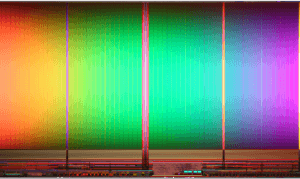What is NAND Flash Memory and why is it used in Solid State Drives (SSD)?
 NAND Flash Memory is a non-volatile memory device which stores blocks as opposed to bytes of data as with NOR flash. It was developed to be lower cost, have improved endurance and read/write performance than NOR flash. Since NAND flash stores more data on the same physical area of silicon, chip densities are increased and production costs reduced.
NAND Flash Memory is a non-volatile memory device which stores blocks as opposed to bytes of data as with NOR flash. It was developed to be lower cost, have improved endurance and read/write performance than NOR flash. Since NAND flash stores more data on the same physical area of silicon, chip densities are increased and production costs reduced.
Non-volatile signifies the NAND memory retains data if power is removed. This differs from volatile memory, like DRAM, which loses content once power is removed. The block architecture, better performance and endurance of NAND flash makes it ideal to store large amounts of data.
A Brief History of Flash Memory
 EPROM (Erasable Programmable Read Only Memory), were memory devices developed by Intel in 1971, which required a UV Light source to erase the entire device through a small window on the top of the chip.
EPROM (Erasable Programmable Read Only Memory), were memory devices developed by Intel in 1971, which required a UV Light source to erase the entire device through a small window on the top of the chip.
In 1978, EEPROM (Electrically Erasable Programmable Read Only Memory) technology was also developed by Intel. EEPROM was an improvement over EPROM since it did not need a UV Light source for erasure.
Flash memory, including NOR and NAND varieties we use today, was developed ~1980 and introduced in 1984 by Toshiba. As mentioned earlier, the lower cost and data storage attributes of NAND have created demand in many markets such as:
- Flash Memory Cards
- USB Flash Drives
- MP3 Players
- Mobile Phones
- Digital Still Cameras
- Navigation Systems
- Digital Video Recorders
- Solid State Drives
Different Types of NAND Flash
There are several types of NAND flash in the market targeting different requirements. Each type of NAND has its advantages and disadvantages as seen in the table below. What is a solid state drive that is right for your application?:
| NAND TECHNOLOGY | BITS / CELL | ENDURANCE CYCLES | RELIABILITY | COST |
|---|---|---|---|---|
| SLC NAND SINGLE-LEVEL-CELL |
1 | 70,000 | HIGH | $$$$$ |
| MLC NAND MULTI-LEVEL-CELL |
2 | 3,000 | MEDIUM | $$ |
| TLC NAND TRI-LEVEL-CELL |
3 | 300 | LOW | $ |
For an in-depth discussion of these technologies and their future, see our SLC versus MLC White Paper.
Challenges with NAND Flash
As with all technologies, there are characteristics of NAND flash which need to be understood for proper design in an application. The 3 main items to be addressed are:
- Limited Endurance Cycles - Each physical flash block has a limited number of endurance cycles from as low as 300 for TLC NAND up to 70,000 for the current SLC NAND
- Block Erase - The internal architecture of a NAND chip requires an entire block to be erased as opposed to a byte of data
- Read and Write Disturb - As NAND flash is produced at fabs with ever decreasing trace widths, adjacent cells in the latest NAND are more affected when reads and writes occur
The latest controllers used in SSD and flash cards have differing techniques to address these shortcomings of NAND flash. Our SLC versus MLC white paper provides greater detail of these issues and solutions.
If you have any other questions, please contact us for more information.






